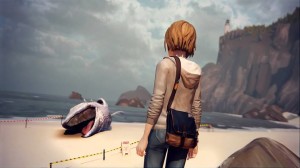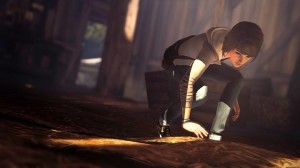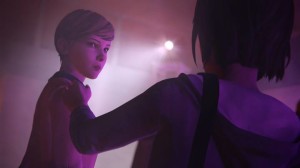Sound and Vision Rating 9.5/10
Life is Strange: Episode 4 – Dark Room is a third-person episodic adventure game available for download from the PlayStation Store for the PS4. The episodic action of Life is Strange continues with the fourth episode developed by Dontnod Entertainment who are known for creating games with powerful and dependant female characters that grow and become stronger through the duration of the game having previously released Remember Me in 2013.
The story of Episode 4 begins with a recap of the events that unfolded in the previous three episodes with the continuation of the story revolving around the lead character who following the thrilling and intensely emotional events of the first two episodes and the moving climax to the third episode is now trying to find her way around a world which she is not entirely familiar with as well as continuing the thorough investigation to find answers in their attempt to solve four mysterious puzzles between what exactly happened to her own friend, her best friend Chloe’s missing friend, the influence of the Prescott family on Arcadia Bay and the ominous incoming storm.
Max discovers that she can manipulate time by rewinding it in order to use the knowledge she has gained to her advantage in overcoming a situation by gaining answers to an important question or doing the opposite of the actions previously attempted as players try to change the outcome of a bad scenario. Rewinding time can also help players to guide their actions in regards to the choices made and the consequences of those decisions, while it generally helps with a variety of puzzles and conversations. A perfect scenario of this is when Max and Chloe are attempting to retrieve information from Frank in which if pushed too far; Frank will grab Max, pull a gun on Chloe and have his dog bite Chloe’s leg, therefore there is a high probability of having to rewind time on at least three occasions before finally getting through to Frank and retrieving the required information to help the investigation.
Another great example of Max’s time manipulation powers is when she is attempting to break the padlock on a door and in doing so requires the use of an old heavy motor to be pulled towards her from the highest level of the barn in order to climb up to that level, but needs the motor once again in an effort to break the padlock, therefore utilising her time manipulation powers allows Max to stand atop of the highest level of the barn with the motor next to her which could not have otherwise been lifted up. This is an excellent design choice as it means that the standout mechanic of the game is not just a gimmick as it is actually used effectively which is quite easy to see that a genuine thought process has been invested in taking the time to implement scenarios that would fit well to the time manipulation mechanic.
The Choices feature is quite reminiscent of the My Choices feature found in The Walking Dead episodic games by providing an entire listing of your choices including the statistical analysis regarding the percentage of players who have made the same choice as you and the percentage of those who have made a different decision for each moral decision with the feature being directly available from the main menu.
There is a form of collectibles that are scattered throughout the episode in which Max can take a photo of a specific event such as squirrels eating nuts or of Bigfoot style footprints at the back of the men’s dormitory with a total of ten optional photos that player’s must be wary of encountering at any given moment within particular areas in order to find them. The optional photos are a positive design choice as it encourages a greater amount of exploration but it is made even better by how players can return to any area of the episode in search of the optional photo that may have been missed without it interfering with previously chosen decisions by playing in collectibles mode.
The supporting characters certainly change in their behavioural patterns and evolve more throughout the duration of the fourth episode in comparison to the previous three, while the entire cast of characters continue to be very unique in their personalities in regards to how they bully other people and having certain behaviour patterns such as being shy, sarcastic, aggressive, knowledgeable, talkative or friendly, while the male and female characters have their own diverse fashion styles that really set them apart in how they look as strong characters emerge throughout the story.
The environment design is excellent as players explore Max’s hometown of Arcadia Bay in Oregon such as a walk along the beach as whales are washed up on the shore during a beautiful sunset, Chloe’s house, Blackwell Academy’s surrounding grounds and dorm rooms, a dusty old, creaky and mysterious barn and much more besides with every area looking distinctly different which is a positive due to the variety of scenery that is provided across the environments.
The performance during remote play is just as excellent as the three previous episodes with the graphics, audio and general performance are all at the same level of quality as the PS4 version, while the control scheme has been appropriately optimised resulting in a comfortable control scheme during remote play as moving faster has moved from R2 to the top right of the touch screen, although it would have perhaps been better suited to the R button instead, while tapping the touch pad to open Max’s journal has been mapped to the touch screen and R3 has been mapped to the rear touch pad to re-centre the camera.
The controls are well mapped to the DualShock 4 controller with the control scheme consisting of pressing triangle, O, X or square to perform contextual actions; holding L2 to rewind time while holding R2 to rewind time faster, holding R2 to move faster, pressing R3 to re-centre the positioning of the camera, changing the direction of the left analogue stick to move Max, changing the direction of the right analogue stick to move the camera, pressing the share button takes players to the share feature menu and pressing the options button to display the pause menu. The touch pad implementation displays Max’s journal by tapping the touch pad, while the light bar implementation remains a light shade of orange throughout gameplay and menus, alongside vibration that is scattered throughout the game for heavy objects falling or loud noises.
The graphics have quite a stylistic approach to rewinding time comprising of such special visual effects as overlapping screen space particles, double exposure and post-processes to create a very unique look that captures the imagination as to exactly what the eyes would possibly see during time travel and time manipulation, while the excellent lighting and shadow effects are showcased at their very best during the Vortex Club party as there is a variety of strobe lighting, alongside superb character models with fluent and natural character movements, although the lip syncing still does not quite match the voice-overs for the majority of the characters and lines of dialogue.
The presentation of the game is solid with a great user interface across various menus such as the main, episodes, help and options, additional content and gameplay menus with support for navigation via the left analogue stick, directional pad and face buttons, although it does not include support for navigation via the right analogue stick and touch pad. The background of the menu screens gradually evolves from beautiful, picturesque scenery of a sunset over a town which is situated next to the coast line with foliage gently swaying in the wind into something nowhere near as tranquil.
The voice-over cast deliver exceptional performances with realistic dialogue to the age range of each character which if anything makes each of the characters even more diverse rather than too serious during light hearted moments or one dimensional with Max having a particularly humorous line of dialogue in which she whispers “MaxGyver strikes again!” after having worked out how to successfully break a padlock. No new characters are introduced into the fourth episode, although there is continuity of characters and the performances maintain the same high standards as previous episodes including Hannah Telle delivering an amazing performance as the lead character Maxine Caulfield while Ashly Burch voices Chloe Price having also voiced Ayla in Awesomenauts, Tiny Tina in Borderlands 2, and Cassie Cage in Mortal Kombat X.
Former X Factor USA finalist Dani Knights voices Victoria Chase, Derek Phillips voices Max’s photography teacher Mark Jefferson having previously voiced Lord Treavor Pendleton in Dishonored and Officer Scott and Kurt Wehlander in Murdered: Soul Suspect as well as roles in television series such as Billy Riggins in Friday Night Lights and Travis Murphy in Longmire. Cissy Jones, having voiced Katjaa in The Walking Dead: Season 1, Shel and Dee in The Walking Dead: 400 Days voices the character of Joyce Price and as Joe Ochman voicing Chloe’s father William Price having previously voiced Jiminy Cricket in Kingdom Hearts HD 2.5 Remix, Elyson in Dragon’s Dogma and Professor Howard MacDougal and a Government Clerk in Red Dead Redemption.
The sound effects include Max as well as other characters walking, running and generally interacting with their surroundings and nearby people, while there is just as much ambience in comparison to the three previous episodes such as birds tweeting, a barking dog and the reaction of people around Max as they go about their everyday lives, while the amazing soundtrack consists of hand picked indie music from rock to melodic acoustic ballads which perfectly set the tone and atmosphere of the scenes they accompany from artists such as Amanda Palmer, Message to Bears, Breton, Bright Eyes and Sparklehorse with the score composed by Jonathan Morali of Syd Matters which can be heard in the main menu and credits. There is no DualShock 4 speaker implementation which is surprising as it could have produced voice-overs, sound effects, ambient sound effects or music to provide a further layer of audio.
The trophy list for the fourth episode includes 12 bronze trophies with the complete trophy list featuring 61 with 59 bronze, 1 gold and 1 platinum trophy. The trophies are all pretty simple for the fourth episode as long as players know the mechanics of the game as they have to take 10 optional photos which will provide 11 trophies such as the Time-Lapsed bronze trophy for taking optional photo number 2 of the bird nest behind the plank of wood in the garage, while the remaining Dark Room bronze trophy is awarded for completing the fourth episode. It is estimated that depending upon skill and a good trophy guide to provide some helpful tips that it would take between 2 to 3 hours to 100% the fourth episode and 10 to 15 hours to platinum the trophy list.
There are no difficulty levels but there is a rather fitting difficulty curve as there are plenty of puzzles to solve which are related to rewinding time, resulting in the difficulty curve being the equivalent to how quickly players adapt to the time manipulation mechanics. There will most probably be a few puzzles that may not be initially obvious in regards to what is required in order to solve them, but with some experimenting players will work out the requirements of the puzzles within a few minutes.
There are no online leaderboards and no local or online multiplayer, although players would arguably not really expect a multiplayer component in something that is as story and character driven as Life is Strange. However, despite there being no online leaderboards, there is a statistical analysis of the decisions that players have made throughout the duration of the episode in comparison to the decisions that everyone else across the world who have played the fourth episode of Life is Strange have made, which is a positive design choice in the sense that it provides the player with an in depth look at if the correct or incorrect decision in comparison to other players. Every decision within the fourth episode is clearly defined in the statistical analysis and it is incredibly interesting to what percentage of players made the same decisions and to also see the percentage of players that chose to go in an opposite direction.
The replayability of the game revolves around the excellent story and strong developing characters, while the unpredictability of how situations will play out given that the outcome can be changed by experimenting with rewinding time which will collectively have you playing beyond the initial playthrough consisting of two to three hours worth of gameplay for the fourth episode to see how differently scenarios can play out and people can react to your decisions and approaches to conversations.
Overall, the fourth episode of Life is Strange is just as much of a thrilling and emotional experience as the previous three episodes, therefore continuing to maintain a pace which delivers an exceptional level of quality throughout from story telling to character progression and some thoughtful puzzles which culminates in shocking twists and turns in the fourth episode which ultimately sets the story on track for a thrilling climax in the concluding episode of what is rapidly cementing a place as one of the best episodic videogame stories to date.
Jason Bonnar
Analysis
- Title: Life is Strange: Episode 4 – Dark Room
- Developer: Dontnod Entertainment
- Publisher: Square Enix
- System: PS4
- Format: PSN Download
- Cross-Buy: No
- Cross-Play: No
- Players: 1
- Hard Drive Space Required: 4.4GB (Episode 4)/6.83GB (Episodes 1 and 4 – Version 1.04)


